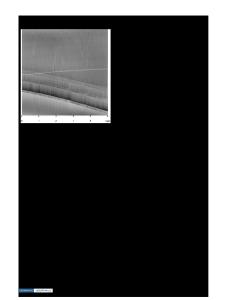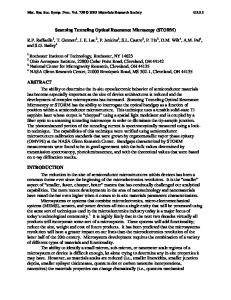Scanning Tunneling Microscopy Imaging of Defects in Layered Compounds
- PDF / 1,652,853 Bytes
- 6 Pages / 420.48 x 639 pts Page_size
- 65 Downloads / 327 Views
SCANNING TUNNELING MICROSCOPY IMAGING OF DEFECTS IN LAYERED COMPOUNDS G. P. E. M. Van Bakel*, J. Th. M. De Hosson°, T. Hibma°" "Department of Applied Physics, University of Groningen, Materials Science Centre, Nijenborgh 18, 9747 AG Groningen, The Netherlands. "" Laboratory of Inorganic Chemistry, University of Groningen, Materials Science Centre, Nijenborgh 16, 9747 AG Groningen, The Netherlands ABSTRACT Structural features of TiS 2 were studied by scanning tunneling microscopy (STM) and single-crystal X-ray diffraction was applied as a complementary technique. STM images in air and at room temperature revealed, beside the trigonal symmetry of the lattice, several new features having this symmetry as well. We conclude that these features not only are to be described by structural defect phenomena which affect octahedral sites in the 1T-CdI2 structure but tetrahedral sites as well. Sample orientation determination by X-ray diffraction provides a unique relation between feature types and sites. A model is proposed in which displaced Ti atoms account for the observed features. INTRODUCTION The scanning tunneling microscope is a new concept in surface characterization which enables imaging of the electronic properties of surfaces on an atomic scale. The excitement of this microscope, developed by G. Binnig, H. Rohrer and associates, lies in the expectation that it may resolve the geometric and electronic structure of almost any surface on a truly atomic scale without assuming the periodicity of a crystal [1]. In this technique an extremely fine probe tip is scanned in close proximity to the surface under investigation. A potential is applied to the surface and the tunnel current which flows between the tip and the surface is measured. The tunnel current is strongly dependent on the tip to surface separation d. As the probe is scanned the tip to surface separation is controlled to give constant tunnel current. In this way an image of the surface topography is obtained. Information about the electronic structure of the surface can be obtained by modulation of one of the gap parameters (applied voltage and tip to surface distance) and subsequent phase sensitive detection of the tunnel current. An STM operates by positioning a sharp metallic tip (in the best case, atomically sharp) a few atomic diameters above a conducting sample on which a bias voltage has been placed with respect to the tip. At a distance under 1 nm, a tunneling current will flow from the sample to tip. In operation, the bias voltages are typically from 10 to 1000 mV and the tunneling currents from 0.2 to 10 nA. The tunneling current varies exponentially with the tip-sample separation, decreasing typically a factor of 2 when the separation is increased by 0.02 nm. An electronic feedback loop is used to keep the tunneling current constant by adjusting the tip-sample separation. Even if the tunneling current is only kept constant to 20%, the tip-sample separation is kept constant to 0.02 nm. Because of the rapid decrease in tunneling current with tip-samp
Data Loading...









